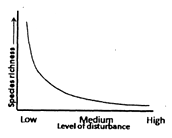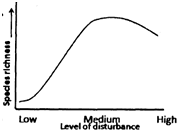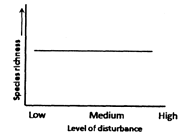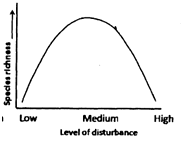 Multiple Choice Questions
Multiple Choice QuestionsWhich of the following groups of species are typical of grassland habitats in India
Black buck, wolf, great Indian bustard, lesser florican
Spotted deer, dhole, peacock, finch lark
Sambar, tiger, paradise fly catcher
Otter, cormorant, darter, pelican
Batrachochytrium dendrobatidis, a fungus, has been implicated in the decline of populations of
Fish
Frogs
Pelicans
Bats
During a field study, three insects with the following characteristics were observed:
A. Elongate, membranous wings with netlike venation, long and slender abdomen, large compound eyes.
B. Small bodied, sucking mouth parts, narrow wings fringed with setae.
C. sclerotized forewings, membranous hindwings, chewing mouth parts
They can be identified to their respective orders as
A – Orthoptera; B – Hemiptera; C – Coleoptera
A – Odonata; B – Coleoptera; C – Hemiptera
A – Orthoptera; B – Odonata; C – Coleoptera
A – Odonata; B – Thysanoptera; C – Coleoptera
Which of the following is NOT true for a critically endangered species?
Reduction of population breeding ability due to increased relatedness through the action of incompatibility mechanisms in plants or behavioral difficulties in animals.
The individuals of the species which have declined to low numbers are still a genetically open system.
Loss of some alleles from the species causing loss of genetic diversity with consequent inability to respond rapidly to selection.
Expression of deleterious alleles and increased homozygosity increases mortality of young, and inbreeding depression leads to reduced offspring fitness.
B.
The individuals of the species which have declined to low numbers are still a genetically open system.
Among the given statements, statement b is not true for critically endangered species.
Suppose you discovered a new species about which you know only two facts: it is small sized ( <10 cm) and short lived (<20 days). Which of the following reproductive strategies is most likely to be true for this species?
Breeds early and more than once in life and produces large number of small-sized offspring.
Breeds late and only once in life and produces large number of small sized offspring.
Breeds early and only once in life and produces large number of small sized offspring.
Breeds early and only once in life and produces a small number of large sized offspring.
Which of the following graphs illustrates the current consensus on the role of disturbance on the species richness of a community?




An organism that has peroxidase and superoxide dismutase but lacks catalase is most likely an
Aerotolerant anaerobe
Aerotolerant aerobe
Obligate anaerobe
Facultative anaerobe
A plant species has been described for the first time by author ‘x’. Later, the species has been transferred to some other genus by author ‘y’. Then the author citation for the new combination will be
x et y
x ex y
(x) y
(y) x
The ‘Tribe’ refers to a taxonomic group recognized between the ranks
Genus and Species
Family and Genus
Order and Family
Class and Order
The group which is no longer considered under fungi is
Ascomycetes
Basidiomycetes
Chytridiomycetes
Oomycetes
